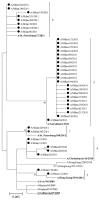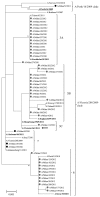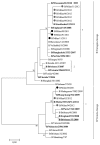Surveillance of influenza viruses in the post-pandemic era (2010-2012) in Northern Italy
- PMID: 23302775
- PMCID: PMC3891725
- DOI: 10.4161/hv.23262
Surveillance of influenza viruses in the post-pandemic era (2010-2012) in Northern Italy
Abstract
The activity and circulation of influenza viruses in Lombardy - Northern Italy - (a region with nearly 10 out of the 60 million inhabitants of Italy) were investigated during two consecutive seasons (2010-2011 and 2011-2012), as part of the Italian Influenza Surveillance Network. The molecular characteristics of the hemagglutinin (HA) sequence of circulating viruses were analyzed to investigate the emergence of influenza viral variants. In the surveyed area, the influenza activity of these two post-pandemic seasons was similar in terms of both time frame and impact. The timing of the influenza epidemics was similar to the timing seen prior to the emergence of the pandemic A(H1N1) virus in 2009. A(H1N1)pdm09 was the predominant virus circulating during the 2010-2011 post-pandemic season and then--unexpectedly--almost disappeared. The HA sequences of these A(H1N1)pdm09 viruses segregated in a different genetic group with respect to those identified during the 2009 pandemic, although they were still closely related to the vaccine viral strain A/California/07/2009. Influenza A(H3N2) viruses were the predominant viruses circulating during the 2011-2012 season, accounting for nearly 88% of influenza viruses identified. All HA sequences of the A(H3N2) viruses isolated in the 2011-2012 season fell into the A/Victoria/208/2009 genetic clade (although the A/Perth/16/2009 virus was the reference vaccine strain). B viruses presented with a mixed circulation of viral variants during these two seasons: viruses belonging to both B/Victoria and B/Yamagata lineages co-circulated in different proportions, with a notable rise in the proportion of B/Yamagata viruses (B/Wisconsin/1/2010-like) during the 2011-2012 epidemic. In conclusion, the continuous monitoring of the characteristics of circulating viruses is an essential tool for understanding the epidemiological and virological features of influenza viruses, for monitoring their matching with seasonal vaccine strains, and for tuning vaccination strategies.
Keywords: Influenza virus; epidemiology; hemagglutinin; influenza surveillance network; influenza vaccination; phylogeny; variants.
Figures






Similar articles
-
Antigenic and genomic characterization of human influenza A and B viruses circulating in Argentina after the introduction of influenza A(H1N1)pdm09.J Med Microbiol. 2014 Dec;63(Pt 12):1626-1637. doi: 10.1099/jmm.0.076208-0. Epub 2014 Oct 28. J Med Microbiol. 2014. PMID: 25351708
-
Genetic drift influenza A(H3N2) virus hemagglutinin (HA) variants originated during the last pandemic turn out to be predominant in the 2011-2012 season in Northern Italy.Infect Genet Evol. 2013 Jan;13:252-60. doi: 10.1016/j.meegid.2012.10.019. Epub 2012 Nov 19. Infect Genet Evol. 2013. PMID: 23174527
-
Ten years (2004-2014) of influenza surveillance in Northern Italy.Hum Vaccin Immunother. 2015;11(1):198-205. doi: 10.4161/hv.35863. Epub 2014 Nov 1. Hum Vaccin Immunother. 2015. PMID: 25483536 Free PMC article.
-
The WHO global influenza surveillance and response system (GISRS)-A future perspective.Influenza Other Respir Viruses. 2018 Sep;12(5):551-557. doi: 10.1111/irv.12565. Epub 2018 Jun 25. Influenza Other Respir Viruses. 2018. PMID: 29722140 Free PMC article. Review.
-
Evolving gene targets and technology in influenza detection.Mol Diagn Ther. 2013 Oct;17(5):273-86. doi: 10.1007/s40291-013-0040-9. Mol Diagn Ther. 2013. PMID: 23686537 Free PMC article. Review.
Cited by
-
3-O-galloylated procyanidins from Rumex acetosa L. inhibit the attachment of influenza A virus.PLoS One. 2014 Oct 10;9(10):e110089. doi: 10.1371/journal.pone.0110089. eCollection 2014. PLoS One. 2014. PMID: 25303676 Free PMC article.
-
Post-pandemic seroprevalence of human influenza viruses in domestic cats.J Vet Sci. 2016 Dec 30;17(4):515-521. doi: 10.4142/jvs.2016.17.4.515. J Vet Sci. 2016. PMID: 27030198 Free PMC article.
-
Influenza virus surveillance in Argentina during the 2012 season: antigenic characterization, genetic analysis and antiviral susceptibility.Epidemiol Infect. 2016 Mar;144(4):751-67. doi: 10.1017/S0950268815001806. Epub 2015 Sep 8. Epidemiol Infect. 2016. PMID: 26345289 Free PMC article.
-
Longitudinal surveillance of influenza in Japan, 2006-2016.Sci Rep. 2022 Jul 14;12(1):12026. doi: 10.1038/s41598-022-15867-3. Sci Rep. 2022. PMID: 35835833 Free PMC article.
References
-
- World Health Organization (WHO) Global Influenza Surveillance Network. (GISN). Strengthening the WHO Global Influenza Surveillance Network (GISN). 2011. Available at: http://www.who.int/influenza/gisrs_laboratory/GISN_Meeting_Report_apr201...
-
- World Health Organization (WHO) Influenza Centre London. September 2012 interim report. Report prepared for the WHO annual consultation on the composition of influenza vaccine for the Southern Hemisphere 2013. 17th–19th September 2012. Available at: http://www.nimr.mrc.ac.uk/documents/about/Interim_Report_September_2012_...
Publication types
MeSH terms
Substances
LinkOut - more resources
Full Text Sources
Other Literature Sources
Medical
